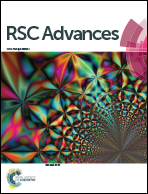Structural transition of ETS1 from an auto-inhibited to functional state upon association with the p16INK4a native and mutated promoter region†
Abstract
Detailed elucidation of structural changes invoked on transcriptional factors and their target genes upon their association is pivotal for understanding the genetic level regulations imposed in several diseases including ovarian cancer. The present study reveals the structural dynamics of ETS1, a member of the E26 transcription factor family, exhibited upon binding with wild and mutant forms of p16INK4a promoter region. The results highlight the presence of a specific type of interactions that control the transition of ETS domain from its auto-inhibited triangle shape to relaxed (oval) conformation. Precisely, the interactions between residues of a triangle basic patch of the HI2–H1 loop, triplet residues at the H3 helix of the ETS domain with a major groove of p16INK4a displaces inhibitory helix HI2 from H4, and transforms ETS1 from auto-inhibited to active form. Further, these interactions induce HI1 helix folding and induce mode I and II distortion in p16INK4a. But, mutations in the E-box motif of the p16INK4a promoter region and at the region preceding E-box motif distorts the DNA mode, changes the interacting pattern with ETS1 and renders the ETS domain in a partial and exact triangle shape. Results emphasize that the mutations in the promoter region impose structural changes in the ETS domain and subsequently affect the expression of tumor suppressor genes in ovarian cancer.


 Please wait while we load your content...
Please wait while we load your content...